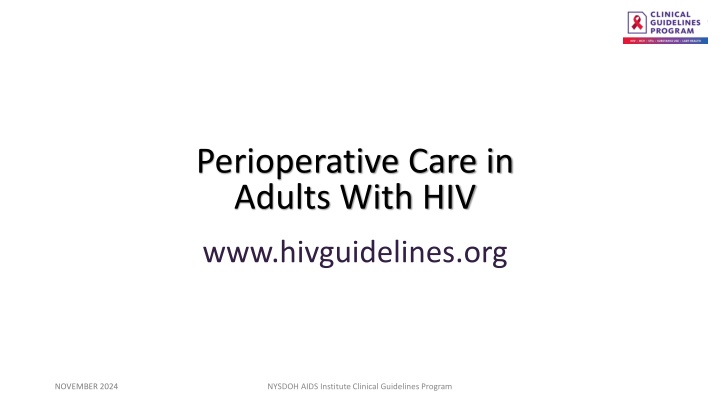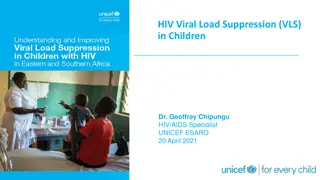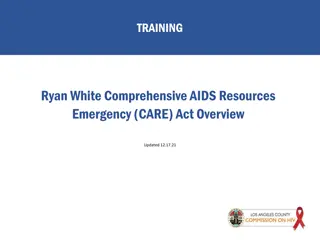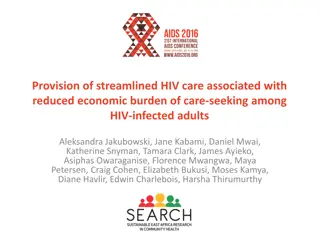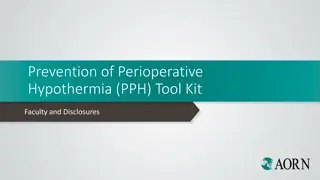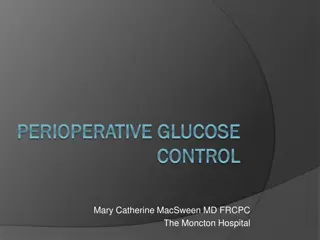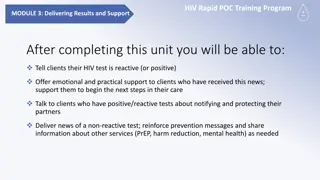Perioperative Care in Adults With HIV: Guidelines and Recommendations
This guideline provides crucial information about managing perioperative care in adults with HIV, emphasizing the importance of HIV status assessment before elective surgery and providing recommendations for surgical interventions based on the patient's viral load and CD4 count. It emphasizes the significance of timely initiation and continuation of antiretroviral therapy to optimize surgical outcomes for HIV-positive individuals.
Download Presentation

Please find below an Image/Link to download the presentation.
The content on the website is provided AS IS for your information and personal use only. It may not be sold, licensed, or shared on other websites without obtaining consent from the author.If you encounter any issues during the download, it is possible that the publisher has removed the file from their server.
You are allowed to download the files provided on this website for personal or commercial use, subject to the condition that they are used lawfully. All files are the property of their respective owners.
The content on the website is provided AS IS for your information and personal use only. It may not be sold, licensed, or shared on other websites without obtaining consent from the author.
E N D
Presentation Transcript
Perioperative Care in Adults With HIV www.hivguidelines.org NOVEMBER 2024 NYSDOH AIDS Institute Clinical Guidelines Program
Purpose of This Guideline Purpose of This Guideline Make clear that HIV is not a contraindication to surgery. Advise that HIV does not increase surgical risk in virally suppressed patients and that HIV transmission to the surgical team is eliminated in virally suppressed patients. Provide guidance for managing risks of elective surgery in patients who are not virally suppressed. Emphasize that interruptions in antiretroviral therapy and opportunistic infection prophylaxis or treatment should be avoided. NOVEMBER 2024 NYSDOH AIDS Institute Clinical Guidelines Program www.hivguidelines.org
Recommendation: Recommendation: Emergency and Urgent Surgery Emergency and Urgent Surgery Clinicians should not delay an emergency or urgent surgical procedure to determine a patient s CD4 count or HIV viral load. (A*) NOVEMBER 2024 NYSDOH AIDS Institute Clinical Guidelines Program www.hivguidelines.org
Recommendations: Recommendations: Elective Surgery: Determine HIV Clinical Status Elective Surgery: Determine HIV Clinical Status As part of the standard preoperative evaluation for patients with HIV, clinicians should review the medical record for results of an HIV viral load test within the previous 6 months and CD4 count within the previous 12 months; if one or both results are not available, the clinician should order laboratory testing to evaluate the patient s HIV clinical status. (A3) If a patient is taking ART and has an HIV viral load <200 copies/mL and a CD4 count >200 cells/mm3, the clinician should proceed with the surgical plan as with a patient who does not have HIV. (A2) If a patient s HIV clinical status suggests an increased risk of surgical complications (e.g., unsuppressed HIV viral load or low CD4 count), the clinician should consult with an experienced HIV care provider to formulate a plan to optimize the patient s HIV treatment and to estimate the likely timeline for improvement in HIV clinical status. (A3) Clinicians should refer patients who are not taking ART to an experienced HIV care provider who can promptly initiate ART. (A1) If optimized ART is likely to improve the patient s clinical status within an acceptable amount of time, then the clinician should inform the patient of the benefits and any potential risks of delaying elective surgery and engage the patient in shared decision-making regarding when to proceed. (A3) If the patient chooses not to pursue a change in HIV treatment or the benefit of surgery will be compromised by waiting, the clinician should explain the potential surgical risks associated with immunosuppression and uncontrolled viremia and engage the patient in shared decision-making regarding when to proceed with elective surgery. (A3) NOVEMBER 2024 NYSDOH AIDS Institute Clinical Guidelines Program www.hivguidelines.org
Recommendations: Recommendations: Continue HIV Medications Continue HIV Medications Clinicians should consult with an experienced HIV care provider before interrupting a patient s ART during the pre- and postoperative period if interruption cannot be avoided. (A1) Clinicians should consult with an experienced HIV care provider before interrupting a patient s treatment or prophylaxis for OIs if interruption cannot be avoided. (A3) NOVEMBER 2024 NYSDOH AIDS Institute Clinical Guidelines Program www.hivguidelines.org
Recommendation: Recommendation: Evaluate for Potential Drug Evaluate for Potential Drug- -Drug Interactions Drug Interactions Clinicians should evaluate potential drug-drug interactions with any surgery-associated medications, with particular attention to drug- drug interactions with PIs, NNRTIs, and boosters such as ritonavir or cobicistat. (A*) NOVEMBER 2024 NYSDOH AIDS Institute Clinical Guidelines Program www.hivguidelines.org
Key Points Key Points The risk of HIV transmission from patient to healthcare worker during surgical procedures is extremely low; from 1985 to 1999, 2 surgical technicians and no surgeons reported occupational HIV transmission to the Centers for Disease Control and Prevention, with none since 1999. When performing surgery on patients with HIV, clinicians should employ standard universal surgical precautions to prevent exposure to blood and bodily fluids. If exposure to the blood or body fluids of a patient with HIV occurs, follow standard institutional protocols and consult the NYSDOH AI guideline PEP to Prevent HIV Infection. In individuals with controlled HIV and higher CD4 counts, the risk of surgical complications and postoperative mortality is approximately the same as in individuals without HIV. NOVEMBER 2024 NYSDOH AIDS Institute Clinical Guidelines Program www.hivguidelines.org
Potential Drug Potential Drug- -Drug Interactions Between Drug Interactions Between Medications Commonly Used in Perioperative Medications Commonly Used in Perioperative Management and Antiretroviral Agents Management and Antiretroviral Agents Perioperative Medication or Class Antiretroviral Medication or Class Anesthetics All boosted PIs: Increased fentanyl blood levels possible due to strong inhibition of CYP3A4 with cobicistat and ritonavir. Monitor for fentanyl-related adverse effects, including potentially fatal respiratory depression. Bictegravir, cabotegravir (oral or injectable), dolutegravir, raltegravir: No change in fentanyl level expected. No dose adjustment required. Elvitegravir, boosted: Increased fentanyl blood levels possible due to strong inhibition of CYP3A4 with cobicistat and ritonavir. Monitor for fentanyl efficacy and adverse effects, including potentially fatal respiratory depression. Lenacapavir: Increased fentanyl blood levels possible due to moderate inhibition of CYP3A4. Consider fentanyl dose reduction until the effects of the combination are known; monitor for respiratory depression and sedation. Fentanyl NOVEMBER 2024 NYSDOH AIDS Institute Clinical Guidelines Program www.hivguidelines.org
Potential Drug Potential Drug- -Drug Interactions Between Drug Interactions Between Medications Commonly Used in Perioperative Medications Commonly Used in Perioperative Management and Antiretroviral Agents Management and Antiretroviral Agents Perioperative Medication or Class Antiretroviral Medication or Class Anesthetics, cont. Atazanavir, unboosted: Possible increased lidocaine levels due to CYP3A4 inhibition from PI. Consider alternative antiretroviral or antiarrhythmic agents. If coadministered, monitor for antiarrhythmic-related adverse effects. All boosted PIs: Possible increased lidocaine levels due to CYP3A4 inhibition from cobicistat and ritonavir. Do not coadminister. Bictegravir, cabotegravir (oral or injectable), dolutegravir, raltegravir: No interaction expected with lidocaine. No dose adjustment needed. Elvitegravir/cobicistat: Possible increased lidocaine levels due to CYP3A4 inhibition from cobicistat. Do not coadminister. Lenacapavir: Possible increase in serum concentrations of the active metabolite(s) of lidocaine (systemic) due to moderate CYP3A4 inhibition; specifically, concentrations of monoethylglycinexylidide may be increased. Magnitude and clinical significance of this interaction appear greater with oral lidocaine administration compared with other administration routes (i.e., intravenous, intramuscular, inhaled); monitor for increased lidocaine toxicities when oral lidocaine is combined with moderate CYP3A4 inhibitors. Lidocaine NOVEMBER 2024 NYSDOH AIDS Institute Clinical Guidelines Program www.hivguidelines.org
Potential Drug Potential Drug- -Drug Interactions Between Drug Interactions Between Medications Commonly Used in Perioperative Medications Commonly Used in Perioperative Management and Antiretroviral Agents Management and Antiretroviral Agents Perioperative Medication or Class Antiretroviral Medication or Class Paralytics and Reversal Agents Boosted PIs: Possible increase in rocuronium bromide levels due to CYP3A4 inhibition from ritonavir and cobicistat. Possible increased risk of myopathy. Elvitegravir, boosted: Possible increase in rocuronium bromide levels due to CYP3A4 inhibition from ritonavir and cobicistat. Possible increased risk of myopathy. Lenacapavir: No interaction expected. No dose adjustment required. Rocuronium NOVEMBER 2024 NYSDOH AIDS Institute Clinical Guidelines Program www.hivguidelines.org
Potential Drug Potential Drug- -Drug Interactions Between Drug Interactions Between Medications Commonly Used in Perioperative Medications Commonly Used in Perioperative Management and Antiretroviral Agents Management and Antiretroviral Agents Perioperative Medication or Class Antiretroviral Medication or Class Sedatives All boosted PIs [b]: Increased midazolam levels expected due to CYP3A4 inhibition. Oral midazolam: Contraindicated; do not coadminister with protease inhibitors. Parenteral midazolam: Can be used in a setting with monitoring and appropriate medical management given possible respiratory depression or prolonged sedation. Consider dose reduction, especially if more than a single dose of midazolam is administered. Efavirenz: Increased or decrease levels of midazolam possible due to effects of efavirenz on CYP3A4. Monitor for therapeutic effectiveness and toxicity of midazolam. Etravirine: Decreased levels of midazolam (AUC by 31%) due to CYP3A4 induction from etravirine. Monitor for therapeutic effectiveness of midazolam. Rilpivirine (oral or injectable), doravirine: No interaction expected. No dose adjustment required. Bictegravir, cabotegravir (oral or injectable), raltegravir: No interaction expected. No dose adjustment required. Elvitegravir/cobicistat: Increased midazolam levels expected due to CYP3A4 inhibition. Oral midazolam: Contraindicated; do not coadminister oral midazolam and elvitegravir/cobicistat. Parenteral midazolam: Can be used in a setting with monitoring and appropriate medical management given possible respiratory depression or prolonged sedation. Consider dose reduction, especially if more than a single dose of midazolam is administered. Lenacapavir: Moderate inhibition of CYP3A4 and P-gP potentially increases midazolam levels. Use with caution; monitor for excess sedation. Midazolam NOVEMBER 2024 NYSDOH AIDS Institute Clinical Guidelines Program www.hivguidelines.org
Potential Drug Potential Drug- -Drug Interactions Between Drug Interactions Between Medications Commonly Used in Perioperative Medications Commonly Used in Perioperative Management and Antiretroviral Agents Management and Antiretroviral Agents Perioperative Medication or Class Antiretroviral Medication or Class Sedatives, cont. Haloperidol See NYSDOH AI Resource: ART Drug-Drug Interactions > Antipsychotics. Atazanavir, unboosted; PIs boosted with cobicistat: No interaction expected. No dose adjustment required. PIs boosted with ritonavir: Decreased olanzapine levels due to CYP450 induction from olanzapine. Monitor for therapeutic effectiveness of olanzapine. Doravirine, etravirine, rilpivirine (oral or injectable): No interaction expected. No dose adjustment required. Efavirenz: Possible reduced olanzapine levels due to CYP3A4 induction from efavirenz. Monitor for therapeutic effectiveness of olanzapine. Bictegravir, cabotegravir (oral or injectable), dolutegravir, elvitegravir/cobicistat, raltegravir: No interaction expected. No dose adjustment required. Lenacapavir: No interaction expected. No dose adjustment required. Olanzapine NOVEMBER 2024 NYSDOH AIDS Institute Clinical Guidelines Program www.hivguidelines.org
Potential Drug Potential Drug- -Drug Interactions Between Drug Interactions Between Medications Commonly Used in Perioperative Medications Commonly Used in Perioperative Management and Antiretroviral Agents Management and Antiretroviral Agents Perioperative Medication or Class Antiretroviral Medication or Class Sedatives, cont. All boosted PIs: Increased antipsychotic levels possible due to CYP3A4 inhibition from ritonavir or cobicistat. Use lowest initial antipsychotic dose. Monitor for adverse events, including QTc prolongation. Quetiapine: Maximum initial dose of quetiapine 1/6 of standard initial dose. Doravirine, rilpivirine (oral or injectable): No interaction expected. No dose adjustment required. Efavirenz, etravirine, nevirapine: Possible decreased antipsychotic levels due to induction from non-nucleoside reverse transcriptase inhibitors. Monitor for therapeutic effectiveness of antipsychotic. Bictegravir, cabotegravir (oral or injectable), raltegravir: No interaction expected. No dose adjustment required. Elvitegravir/cobicistat: Increased antipsychotic levels expected due to CYP3A4 inhibition with cobicistat. Use lowest initial antipsychotic dose. Monitor for adverse events, including QTc prolongation. Quetiapine: Maximum initial dose of quetiapine 1/6 of standard initial dose. Lenacapavir: Increased serum concentration of quetiapine possible due to moderate CYP3A4 inhibition; monitor for increased quetiapine effects and toxicities, including QTc prolongation. Miscellaneous short-acting antipsychotics (risperidone, ziprasidone, quetiapine) NOVEMBER 2024 NYSDOH AIDS Institute Clinical Guidelines Program www.hivguidelines.org
Potential Drug Potential Drug- -Drug Interactions Between Drug Interactions Between Medications Commonly Used in Perioperative Medications Commonly Used in Perioperative Management and Antiretroviral Agents Management and Antiretroviral Agents Perioperative Medication or Class Antiretroviral Medication or Class Miscellaneous, Other Ondansetron No interactions expected. No dose adjustment required. Acid-reducing agents See NYSDOH AI Resource: ART Drug-Drug Interactions > Acid-Reducing Agents. Anticoagulants See NYSDOH AI Resource: ART Drug-Drug Interactions > Anticoagulants. Non-opioid analgesics See NYSDOH AI Resource: ART Drug-Drug Interactions > Nonopioid Pain Medications for potential interactions between NSAIDs and tenofovir disoproxil fumarate. Opioid analgesics See NYSDOH AI Resource: ART Drug-Drug Interactions > Opioid Analgesics and Tramadol. NOVEMBER 2024 NYSDOH AIDS Institute Clinical Guidelines Program www.hivguidelines.org
Need Help? Need Help? NYSDOH AIDS Institute Clinical Guidelines Program www.hivguidelines.org
Access the Guideline Access the Guideline www.hivguidelines.org > Perioperative Care in Adults With HIV Also available: Printable PDF NYSDOH AIDS Institute Clinical Guidelines Program www.hivguidelines.org
